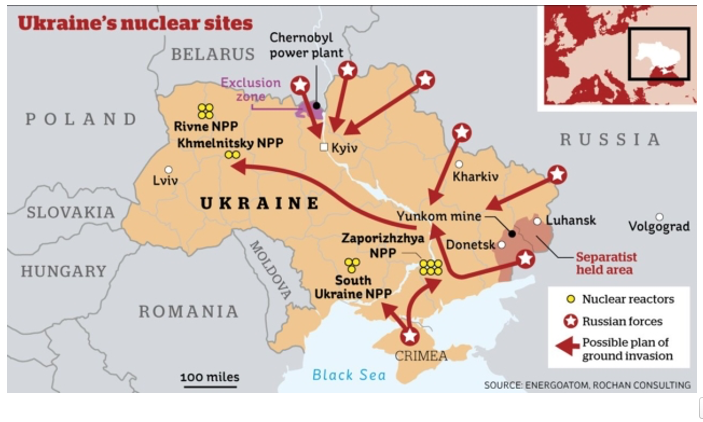CommentsNUCLEAR RISK - Russian forces have captured Chernobyl, a 1,000 square mile radioactive exclusion zone.
But more significantly, what about Ukraine’s nuclear reactors smack dab in the middle of a theatre of war?
A complicating/dangerous aspect of Russia’s invasion is the status of Chernobyl’s sister reactors, 15 reactors at four nuclear power plants exposed in a war zone of bombing, missile attacks and rampant gunfire or perhaps a breakdown of crucial infrastructure that keeps super hot atom-splitting vessel containers and spent fuel rods in open pools of water cool enough to prevent a massive zirconium fire or hydrogen explosion that spews radiation across the countryside.
With an odd twist of bad is good for the enemy, Ukraine’s rickety Russian-designed nuclear power plants serve as a defense mechanism for Putin’s armed forces, essentially prohibiting any involvement by NATO forces that must know that the worst possible tactic would be to escalate warfare in Ukraine with 15 vulnerable nuclear reactors in the line of fire.
Fifty percent (50%) of the country’s electricity generation comes from nuclear. Of heightened concern, some of the 15 operating old Soviet model nuclear reactors are deemed to be so rickety that they would not be allowed to operate in the EU today for safety reasons.
All of Ukraine’s nuclear power units were designed in the Soviet Union, comprising 13 VVER-1000 type reactors and 2 VVER-440 units. None of the units currently meet modern international safety standards. Twelve of the fifteen units have already exceeded their “designed lifetime” of 30 years. (Source: Ukraine’s Nuclear Impasse, The Heinrich Böll Foundation, Brussels, European Union, April 26, 2021)
Following the Fukushima disaster, stress tests were carried out on all European nuclear power plants, including Ukraine: “The aim of the assessments was to check whether the safety standards used when specific power plants received their licenses were sufficient to cover unexpected extreme events. Specifically, the tests measured the ability of nuclear facilities to withstand damage from hazards such as earthquakes, flooding, terrorist attacks or aircraft collisions,” Ibid.
As a result of deficiencies with Ukraine’s nuclear power plants, the Ukraine government approved a Complex Consolidated Safety Upgrade Program with an initial deadline of 2017 funded by a Euro 600 million loan. Because of several postponements, the deadline was shifted to 2023. Therefore, and forebodingly, the existing nuclear power plants are not completely safe, as some safety measures are still not implemented.
Nuclear reactors require a constant supply of electricity and water to operate. As such, infrastructure away from the plants is crucial for on-going operations. Fukushima has already shown what can happen when infrastructure support for a nuclear plant goes bad. Ukraine’s 15 operating reactors depend upon the electric grid to help keep things cool in the event of an abrupt shut down. Additionally, some of the deficiencies found at Ukraine’s reactors had to do with weaknesses exposed by back up generators and electrical control systems.
Misfires or stray artillery or misguided missiles are the main risks, as for example, a thermal power station at Shchastya caught fire only recently amid shelling, leaving 40,000 Ukrainians without electricity.
In the case of destruction of a nuclear power plant, according to Dmytro Gumenyuk, Kyiv nuclear safety expert: “I think the consequences would be so much worse than at Fukushima and Chernobyl together. If speaking about consequences of this war situation, Europe will be totally contaminated.” (Source: Nuclear Risk From War in Ukraine Isn’t Targeted Missiles but Accidental Hits on Reactors, Safety Expert Warns, INews UK, February 24, 2022)
An additional risk is the Chernobyl decommissioning site with 22,000 assemblies of spent nuclear fuel stored in special casks. These are not designed for protection from military firepower: “In case of the destruction of these casks, radioactive materials could be released and transferred to Ukraine and other European territories. This is a very dangerous situation.” (Gumenyuk)
According to the Nuclear Security Index for 2020, under the category “risk environment,” which calculates political stability, effective governance, pervasiveness of corruption, and illicit activities by non-state actors, Ukraine scores a sub-par, lowly 14 out of 100. And, that was before this war.
Yet, there’s even more: A radioactive time bomb is already ticking away at the Yuny Komynar (Yunkom) mine in occupied Donetsk (a Russian breakaway faux state), which has been slowly contaminating the environment for some time but could become a freakish radioactive monster. This stems from a deep underground nuclear test conducted by the Soviet Union in 1979. The nuke explosion melted the walls into glass, creating the Klivazh facility, which is a vitrified capsule of radioactivity. It requires constant pumping of water out of the shaft to prevent flooding.
Prior to Russian occupation, the Ukrainian government spent millions pumping water. But, when the Donetsk People’s Republic (DPR) took over in 2018, pumping operations ceased and the infrastructure was sold for scrap metal.
According to a 2021 report by Truth Hounds, a Ukraine-based human rights NGO, at the Yunkom mine: “There is a risk of the glass capsule being destroyed, and the leaking of highly hazardous radioactive elements into surface waters. Just two months after water pumping ceased, the level of mine water in the shaft of the mine increased by 157 meters.”
Now, the capsule is believed to have flooded, and according to the International Human Rights community, the concentration of radionuclides in the aquifers 5km away from the site register 20-34*103 becquerels/kg. Accordingly, low-level radioactive waters are already entering drinking water sources.
A bigger risk yet is the Yunkom mine radioactive cocktail spreading far beyond Ukrainian borders should it seep into the Sea of Azov and the Black Sea on to the Mediterranean Sea.
It should be noted that Russian-backed separatists deny any changes in radiation levels or inordinate risks at the Yunkom mine site. However, it should also be noted that the Russian separatists have denied an International Atomic Energy Agency (IAEA) request to access the site for evaluation purposes.
Meanwhile, Sergiy Kyslytsya, Ukraine’s Ambassador to the United Nations has called upon the UN to carry out an environmental impact assessment in Donetsk and Luhansk.
In the final analysis, the Ukrainian/Russian imbroglio is like falling into a surreal state “down the rabbit hole,” not knowing what peril is right around the corner or when it’ll strike but knowing it lurks in the shadows with enormously devastating impact.
(Robert Hunziker, MA, economic history DePaul University, awarded membership in Pi Gamma Mu International Academic Honor Society in Social Sciences is a freelance writer and environmental journalist who has over 200 published articles appearing in over 50 journals, magazines, and sites worldwide.)

















